Knowledge of earths interior is mostly derived from information
Home » Wallpapers » Knowledge of earths interior is mostly derived from informationYour Knowledge of earths interior is mostly derived from images are available. Knowledge of earths interior is mostly derived from are a topic that is being searched for and liked by netizens now. You can Find and Download the Knowledge of earths interior is mostly derived from files here. Download all royalty-free vectors.
If you’re looking for knowledge of earths interior is mostly derived from images information linked to the knowledge of earths interior is mostly derived from topic, you have come to the right site. Our site always gives you hints for viewing the maximum quality video and image content, please kindly surf and locate more informative video content and images that fit your interests.
Knowledge Of Earths Interior Is Mostly Derived From. -most of our knowledge of earths interior comes from the study of earthquake waves seismic waves -travel times of P compressional and S sheer waves through the earth vary depending on the properties of the materials. It is widely accepted that the Earths interior is composed of several layers. Extensive knowledge of the Earths interior has been derived from a variety of measurements however including seismic waves produced by quakes that travel through the Earth measurements of the flow of heat from the Earths interior into the outer crust and by. The crust the mantle and the core.
 Inside Earth Earth Science From courses.lumenlearning.com
Inside Earth Earth Science From courses.lumenlearning.com
Learn vocabulary terms and more with flashcards games and other study tools. Knowledge of Earths interior is mostly derived from indirect evidence involving the analysis of seismic waves. Most of our knowledge of Earths interior comes from the study of Click again to see term 130 THIS SET IS OFTEN IN FOLDERS WITH. Hence the best model for the source of the oceans at the moment is a combination of water derived from comets and water that was caught up in the rocky body of the earth as it formed. These studies allow further refinement of our knowledge of what the interior of the earth is made of and how it behaves. Studies on the more distant mantle and core have more limited opportunities samples.
Most of the Earths interior is hotter than all known Curie temperatures and cooler crustal rocks just dont contain enough magnetic content to account for the magnetic field and crustal magnetization is very heterogeneous in any case.
Since the crust is readily accessible scientists have been able to perform hands-on experiments to determine its composition. The crust the mantle and the core. Knowledge of Earths interior is mostly derived from indirect evidence involving the analysis of seismic waves. Earths interior is generally divided into three major layers. Start studying Earths Interior. Since the crust is readily accessible scientists have been able to perform hands-on experiments to determine its composition.
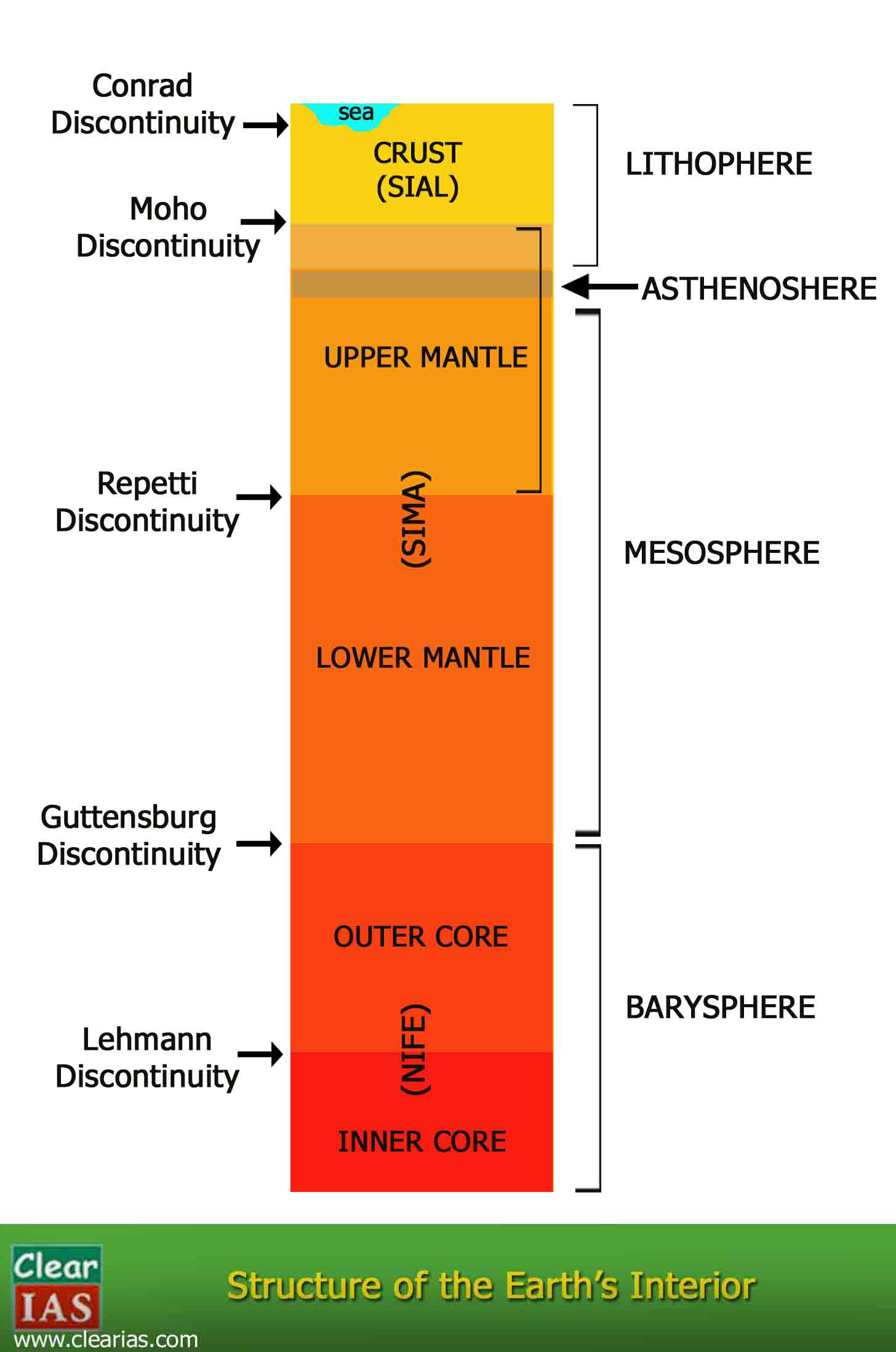 Source: clearias.com
Source: clearias.com
Hence the best model for the source of the oceans at the moment is a combination of water derived from comets and water that was caught up in the rocky body of the earth as it formed. The internal structure of Earth structure of the solid Earth or simply structure of Earth refers to concentric spherical layers subdividing the Solid earth ie excluding Earths atmosphere and hydrosphereIt consists of an outer silicate solid crust a highly viscous asthenosphere and solid mantle a liquid outer core whose flow generates the Earths magnetic field and a solid inner core. 18The division of the Earths interior into crust and mantle as shown in the diagram is based primarily on the study of Aaluminum and iron Bsodium and chlorine Ccalcium and carbon Doxygen and silicon 19What are the two most abundant elements by mass found in Earths crust. Earths interior is generally divided into three major layers. The discovery of the liquid outer.

Learn vocabulary terms and more with flashcards games and other study tools. These experiments support the theory that the mantle is ultramafic and the core is mostly iron and nickel because they show that materials with those compositions have the same density and seismic wave speeds as have been observed in the earth. Earths interior is generally divided into three major layers. 18The division of the Earths interior into crust and mantle as shown in the diagram is based primarily on the study of Aaluminum and iron Bsodium and chlorine Ccalcium and carbon Doxygen and silicon 19What are the two most abundant elements by mass found in Earths crust. -most of our knowledge of earths interior comes from the study of earthquake waves seismic waves -travel times of P compressional and S sheer waves through the earth vary depending on the properties of the materials.
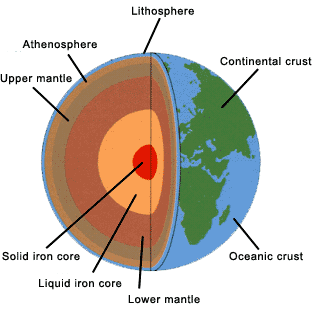 Source: wildcountryfinearts.com
Source: wildcountryfinearts.com
Direct sampling of the interior using deep-test wells. Studies on the more distant mantle and core have more limited opportunities samples. Other important data on the Earths interior come from geological observation of surface rocks and studies of the Earths motions in the Solar System its gravity and magnetic fields and the flow of heat from inside the Earth. Learn vocabulary terms and more with flashcards games and other study tools. The hard brittle crust extends from Earths surface to the so-called Mohorovicic discontinuity nicknamed the Moho.
 Source: wildcountryfinearts.com
Source: wildcountryfinearts.com
Start studying Earths Interior. The crust the mantle and the core. 18The division of the Earths interior into crust and mantle as shown in the diagram is based primarily on the study of Aaluminum and iron Bsodium and chlorine Ccalcium and carbon Doxygen and silicon 19What are the two most abundant elements by mass found in Earths crust. Direct sampling of the interior using deep-test wells. The crust the mantle and the core.
 Source: wildcountryfinearts.com
Source: wildcountryfinearts.com
Since the crust is readily accessible scientists have been able to perform hands-on experiments to determine its composition. Most of our knowledge of Earths interior comes from the study of Click again to see term 130 THIS SET IS OFTEN IN FOLDERS WITH. Afluorite and calcite Bmagnetite and pyrite Camphibole and quartz. Knowledge of the Earths interior is based on the reactions of seismic waves from earthquakes to the density and state of materials that they encounter. Earths interior is generally divided into three major layers.
 Source: courses.lumenlearning.com
Source: courses.lumenlearning.com
These experiments support the theory that the mantle is ultramafic and the core is mostly iron and nickel because they show that materials with those compositions have the same density and seismic wave speeds as have been observed in the earth. Extensive knowledge of the Earths interior has been derived from a variety of measurements however including seismic waves produced by quakes that travel through the Earth measurements of the flow of heat from the Earths interior into the outer crust and by. Earths interior is generally divided into three major layers. Hence the best model for the source of the oceans at the moment is a combination of water derived from comets and water that was caught up in the rocky body of the earth as it formed. These studies allow further refinement of our knowledge of what the interior of the earth is made of and how it behaves.
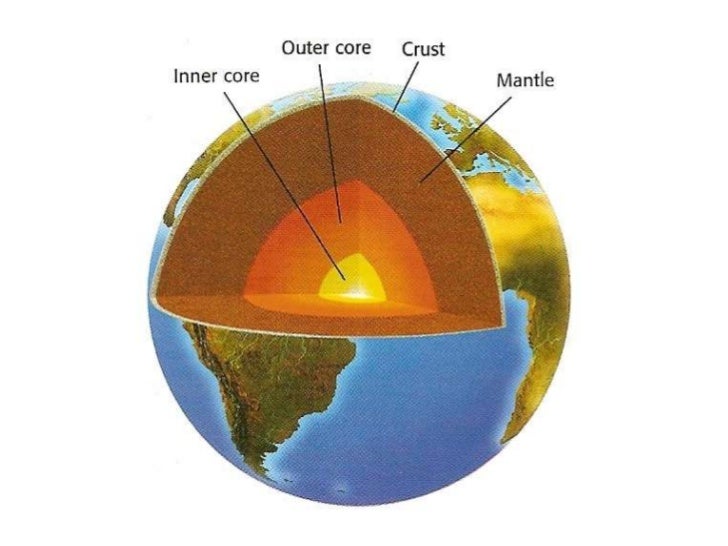 Source: wildcountryfinearts.com
Source: wildcountryfinearts.com
These experiments support the theory that the mantle is ultramafic and the core is mostly iron and nickel because they show that materials with those compositions have the same density and seismic wave speeds as have been observed in the earth. The crust the mantle and the core. Extensive knowledge of the Earths interior has been derived from a variety of measurements however including seismic waves produced by quakes that travel through the Earth measurements of the flow of heat from the Earths interior into the outer crust and by. Learn vocabulary terms and more with flashcards games and other study tools. Knowledge of the Earths interior is based on the reactions of seismic waves from earthquakes to the density and state of materials that they encounter.
 Source: in.pinterest.com
Source: in.pinterest.com
Studies on the more distant mantle and core have more limited opportunities samples. The crust the mantle and the core. Historic and prehistoric records. The discovery of the liquid outer. By Kimberly Yavorski.
 Source: nationalgeographic.com
Source: nationalgeographic.com
The discovery of the liquid outer. Knowledge of Earths interior is mostly derived from indirect evidence involving the analysis of seismic waves. By Kimberly Yavorski. The crust the mantle and the core. These experiments support the theory that the mantle is ultramafic and the core is mostly iron and nickel because they show that materials with those compositions have the same density and seismic wave speeds as have been observed in the earth.

Knowledge of the Earths interior is based on the reactions of seismic waves from earthquakes to the density and state of materials that they encounter. Learn vocabulary terms and more with flashcards games and other study tools. Other important data on the Earths interior come from geological observation of surface rocks and studies of the Earths motions in the Solar System its gravity and magnetic fields and the flow of heat from inside the Earth. 18The division of the Earths interior into crust and mantle as shown in the diagram is based primarily on the study of Aaluminum and iron Bsodium and chlorine Ccalcium and carbon Doxygen and silicon 19What are the two most abundant elements by mass found in Earths crust. -most of our knowledge of earths interior comes from the study of earthquake waves seismic waves -travel times of P compressional and S sheer waves through the earth vary depending on the properties of the materials.
 Source: courses.lumenlearning.com
Source: courses.lumenlearning.com
Other important data on the Earths interior come from geological observation of surface rocks and studies of the Earths motions in the Solar System its gravity and magnetic fields and the flow of heat from inside the Earth. The discovery of the liquid outer. Studies on the more distant mantle and core have more limited opportunities samples. It is widely accepted that the Earths interior is composed of several layers. Hence the best model for the source of the oceans at the moment is a combination of water derived from comets and water that was caught up in the rocky body of the earth as it formed.
 Source: slideplayer.com
Source: slideplayer.com
Learn vocabulary terms and more with flashcards games and other study tools. By Kimberly Yavorski. The internal structure of Earth structure of the solid Earth or simply structure of Earth refers to concentric spherical layers subdividing the Solid earth ie excluding Earths atmosphere and hydrosphereIt consists of an outer silicate solid crust a highly viscous asthenosphere and solid mantle a liquid outer core whose flow generates the Earths magnetic field and a solid inner core. Knowledge of Earths interior is mostly derived from indirect evidence involving the analysis of seismic waves. Learn vocabulary terms and more with flashcards games and other study tools.

By Kimberly Yavorski. It is widely accepted that the Earths interior is composed of several layers. Knowledge of Earths interior is mostly derived from indirect evidence involving the analysis of seismic waves. Most of our knowledge of Earths interior comes from the study of Click again to see term 130 THIS SET IS OFTEN IN FOLDERS WITH. Afluorite and calcite Bmagnetite and pyrite Camphibole and quartz.
 Source: nap.edu
Source: nap.edu
The discovery of the liquid outer. It is widely accepted that the Earths interior is composed of several layers. Since the crust is readily accessible scientists have been able to perform hands-on experiments to determine its composition. By Kimberly Yavorski. Knowledge of the Earths interior is based on the reactions of seismic waves from earthquakes to the density and state of materials that they encounter.
 Source: slideplayer.com
Source: slideplayer.com
Start studying Earths Interior. Earths interior is generally divided into three major layers. By Kimberly Yavorski. The hard brittle crust extends from Earths surface to the so-called Mohorovicic discontinuity nicknamed the Moho. Other important data on the Earths interior come from geological observation of surface rocks and studies of the Earths motions in the Solar System its gravity and magnetic fields and the flow of heat from inside the Earth.
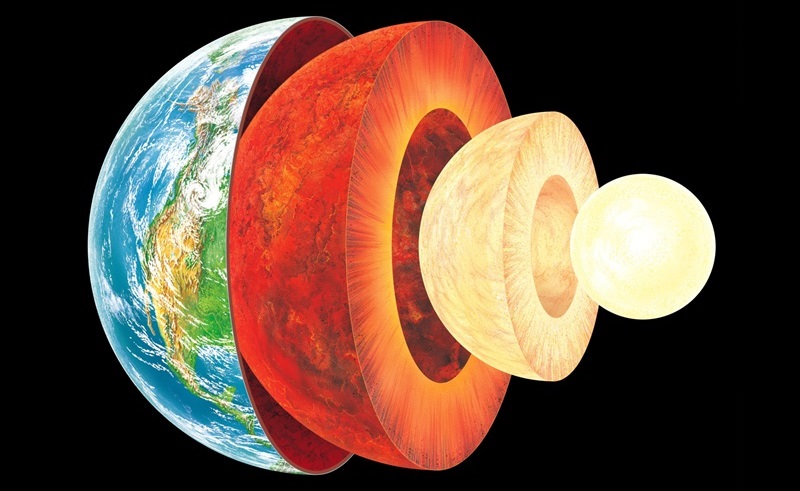 Source: universetoday.com
Source: universetoday.com
Earths interior is generally divided into three major layers. Extensive knowledge of the Earths interior has been derived from a variety of measurements however including seismic waves produced by quakes that travel through the Earth measurements of the flow of heat from the Earths interior into the outer crust and by. By Kimberly Yavorski. 18The division of the Earths interior into crust and mantle as shown in the diagram is based primarily on the study of Aaluminum and iron Bsodium and chlorine Ccalcium and carbon Doxygen and silicon 19What are the two most abundant elements by mass found in Earths crust. Knowledge of Earths interior is mostly derived from indirect evidence involving the analysis of seismic waves.
 Source: slideplayer.com
Source: slideplayer.com
Earths interior is generally divided into three major layers. These studies allow further refinement of our knowledge of what the interior of the earth is made of and how it behaves. Most of the Earths interior is hotter than all known Curie temperatures and cooler crustal rocks just dont contain enough magnetic content to account for the magnetic field and crustal magnetization is very heterogeneous in any case. Hence the best model for the source of the oceans at the moment is a combination of water derived from comets and water that was caught up in the rocky body of the earth as it formed. -most of our knowledge of earths interior comes from the study of earthquake waves seismic waves -travel times of P compressional and S sheer waves through the earth vary depending on the properties of the materials.
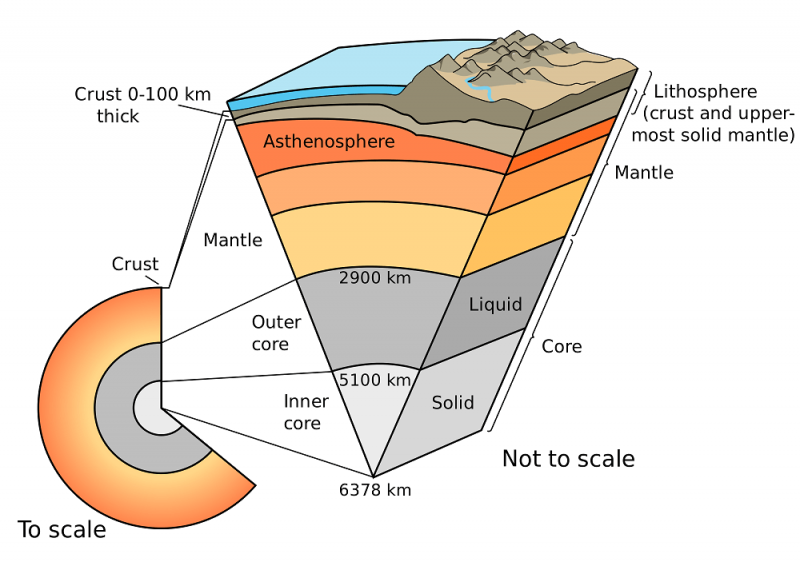 Source: phys.org
Source: phys.org
18The division of the Earths interior into crust and mantle as shown in the diagram is based primarily on the study of Aaluminum and iron Bsodium and chlorine Ccalcium and carbon Doxygen and silicon 19What are the two most abundant elements by mass found in Earths crust. Knowledge of the Earths interior is based on the reactions of seismic waves from earthquakes to the density and state of materials that they encounter. Since the crust is readily accessible scientists have been able to perform hands-on experiments to determine its composition. Afluorite and calcite Bmagnetite and pyrite Camphibole and quartz. Other important data on the Earths interior come from geological observation of surface rocks and studies of the Earths motions in the Solar System its gravity and magnetic fields and the flow of heat from inside the Earth.
This site is an open community for users to do submittion their favorite wallpapers on the internet, all images or pictures in this website are for personal wallpaper use only, it is stricly prohibited to use this wallpaper for commercial purposes, if you are the author and find this image is shared without your permission, please kindly raise a DMCA report to Us.
If you find this site adventageous, please support us by sharing this posts to your preference social media accounts like Facebook, Instagram and so on or you can also save this blog page with the title knowledge of earths interior is mostly derived from by using Ctrl + D for devices a laptop with a Windows operating system or Command + D for laptops with an Apple operating system. If you use a smartphone, you can also use the drawer menu of the browser you are using. Whether it’s a Windows, Mac, iOS or Android operating system, you will still be able to bookmark this website.
Category
Related By Category
- Tour guide license ideas
- Green mantis ideas
- Anacondas images ideas
- Natural selection camouflage ideas
- Fighting cholitas information
- Black history month theme 2015 information
- Traveler catalogue information
- National geographic colorado information
- Holiday planets information
- Pacific ocean animals information